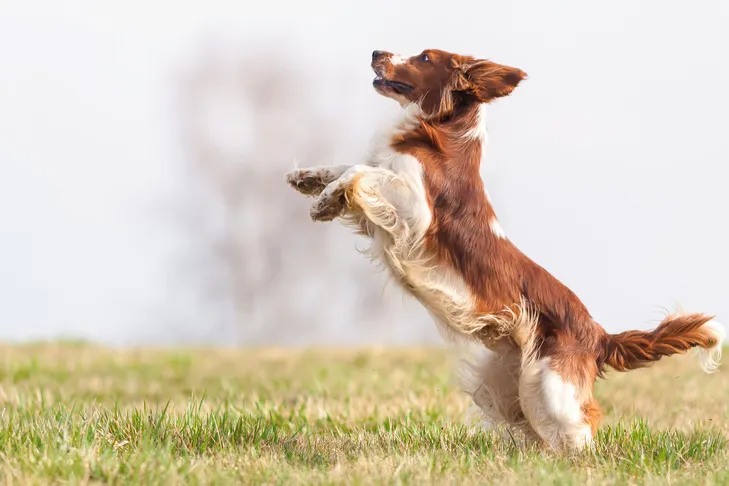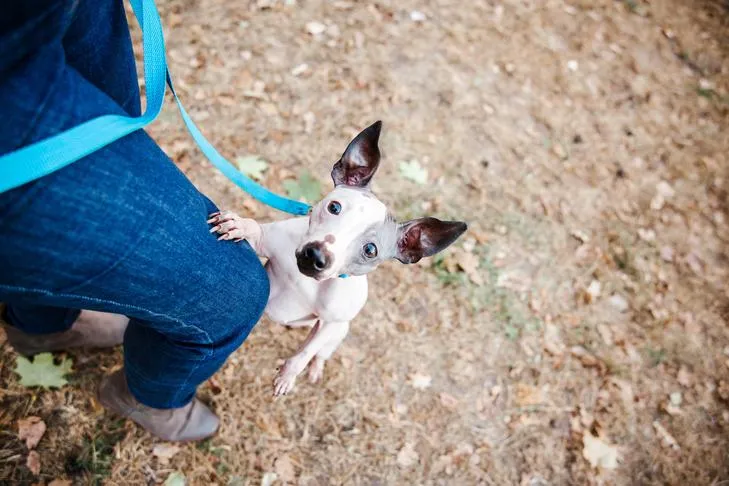One of the most common yet frustrating challenges for dog owners is preventing their canine companions from jumping on people during greetings. While your dog’s enthusiastic leaps are often a sign of pure joy and an attempt to say “hello” face-to-face, they can be annoying, messy, and even dangerous, especially for children or the elderly. Even smaller breeds can leave scratches or muddy paw prints, making this natural canine behavior a problem that needs to be addressed. The good news is that by understanding why your dog jumps and consistently applying effective training techniques, you can teach them a more polite and safer way to greet people. This guide will walk you through practical strategies to help your dog understand the “four paws on the floor” rule, transforming unruly greetings into calm, enjoyable interactions.
1. Only Greet Your Dog When They Have Four Paws on the Floor
The most effective approach to addressing unwanted behaviors is to teach your dog an incompatible alternative. Rather than simply telling them what not to do, show them what to do. For jumping, this means training your dog to keep all four paws on the floor. They cannot jump and stand simultaneously. Alternatively, you might teach them to how to teach sit to a dog or lie down as their preferred greeting behavior. The key is consistency: only provide attention, praise, or affection when your dog is following this specific greeting rule. Avoid exceptions, such as allowing jumping when you’re in casual clothes but not in formal wear, as this confuses your dog and slows down the learning process.
2. Give Attention As Soon As Your Dog’s Front Feet Hit the Floor
Dogs are intelligent creatures who quickly learn to repeat behaviors that yield desired results. Your dog craves your attention, so it’s crucial to reward them immediately when they adhere to your greeting rule. As soon as their front paws are on the floor, offer praise, gentle petting, or a quiet greeting. This immediate positive reinforcement helps your dog understand that “four on the floor” is the behavior that earns your affection. Delays, such as waiting to remove your coat or shoes, can lead to impatience, prompting your dog to revert to jumping to get your notice. Swift and clear rewards are vital, particularly during the initial stages of training, to cement the association between calm behavior and positive outcomes.
3. Remove Attention When Your Dog Jumps
Conversely, to eliminate jumping, you must stop rewarding it entirely. If your dog jumps on you, immediately remove the very thing they seek: your attention. This can be as simple as calmly turning your back, stepping away, or even walking into another room. Your dog will quickly realize that jumping achieves the opposite of their intention. The moment all four paws are back on the floor, turn back and quietly praise and pet them. This consistent on/off switch for attention based on their behavior will clearly communicate to your dog that polite greetings are the way to earn your interaction, while jumping results in your immediate disengagement.
 Welsh Springer Spaniel joyfully jumping up outdoors to greet someone.
Welsh Springer Spaniel joyfully jumping up outdoors to greet someone.
4. Set Up Your Dog for Success
While ignoring jumping and rewarding proper greetings is effective, it can involve a frustrating trial-and-error period for your dog. You can accelerate their learning by proactively setting them up for success. If your chosen greeting rule is for your dog to sit, ask them to sit as soon as you enter the door, before they even have a chance to jump. If it’s “four on the floor,” gently encourage them to remain standing calmly.
A highly effective technique to prevent jumping is to scatter treats on the floor the moment you arrive. Most dogs can’t resist a free treat, and they cannot jump while simultaneously sniffing the ground and foraging for food. Your timing needs to be quick; providing food before they even think about jumping allows you to reward the “four on the floor” position with both attention and a tasty incentive. As your dog consistently grasps the greeting rule, you can gradually phase out the food rewards, relying more on praise and petting.
5. Always Reward Your Dog for Proper Greeting Behavior
Consistency is paramount in dog training. Your dog will learn appropriate greeting behavior much faster if their actions consistently and immediately impact your attention. This means that if your dog follows your greeting rule, you must always reward them. Even if you’ve endured minutes of jumping before they finally settle, do not withhold your attention when they finally place all four paws on the floor. Your irritation from the previous jumping behavior should not influence your response, as inconsistency will confuse your dog and undermine the training. Every time they get it right, they deserve to be rewarded, reinforcing the desired behavior.
6. Don’t Grab or Push Your Dog Away
When your dog jumps, their primary goal is to gain your attention. Crucially, even a negative physical response—such as grabbing their paws, pushing them away, or holding them down—is still a form of attention. This means you are inadvertently reinforcing the very behavior you wish to eliminate, potentially increasing jumping frequency in the long run. Furthermore, for some dogs, especially those with a boisterous personality, physical interventions can be misinterpreted as an invitation to engage in roughhouse play. They might return with even more vigorous jumping, believing it’s all part of an exciting game, rather than understanding it as a deterrent for their unwanted behavior. Maintaining a calm and consistent approach is key to teach a dog to walk on a leash without pulling and other good manners.
 American Hairless Terrier eagerly jumping up on its owner's leg outdoors, seeking attention.
American Hairless Terrier eagerly jumping up on its owner's leg outdoors, seeking attention.
7. Don’t Put Your Knee Up When Your Dog Jumps
A common piece of outdated advice suggests raising your knee to block your dog’s chest when they jump. As with grabbing, this physical interaction can be misinterpreted by some energetic dogs as a form of play or attention, leading to an increase in jumping rather than a decrease. More importantly, for most dogs, this action can create distrust and significantly erode the crucial human-canine bond. Your dog is merely attempting to greet you with excitement, and a harsh, physical response can be perceived as punishment, potentially leading to fear or anxiety during greetings. This breakdown in trust can also manifest in other behavioral issues, such as a reluctance to come when called. You might even inadvertently injure them.
8. Keep Greetings Low-Key While Your Dog Is Learning
Dogs, especially when excited to see their owners, can find it incredibly difficult to control their emotions. Resisting the natural urge to jump and instead adhering to a new, polite greeting rule requires a significant amount of emotional self-control. You can make this easier for your dog by keeping greetings initially low-key. Dogs are highly perceptive to our emotions; if you are overly excited, they will mirror that heightened state. Instead, maintain a calm and quiet demeanor when you first arrive home, even when offering praise. As your dog begins to master the new behavior, you can gradually increase your enthusiasm, allowing for more exuberant greetings once they consistently choose polite interactions. This management of initial excitement can also help if you are wondering how to train a dog to help with anxiety related to overstimulation.
9. Prevent Your Dog From Jumping on Guests
Your dog’s jumping behavior isn’t solely reinforced by you. Other family members, visitors, and even strangers on the street can inadvertently encourage jumping if you’re not proactive. To prevent this, employ effective management techniques. When guests arrive, you can leash your dog, preventing them from physically approaching visitors without your control. Even better, teach your dog to “go to their place” on a mat or bed, or how to train a dog to stay in a kennel so they are calmly contained away from the entryway. Baby gates can also be used to block off the front hall, creating a physical barrier that prevents jumping before it even starts, allowing for controlled introductions when your dog is ready.
10. Ask Guests and Strangers to Follow Your Greeting Rule
Don’t hesitate to clearly communicate your dog’s greeting rules to guests and even polite strangers. While your dog is still in training, ask people to completely ignore your dog unless you explicitly give permission. It’s often best to avoid interactions with unfamiliar people until your dog has mastered polite greetings with friends and family who you know will cooperate with your training methods. When encountering strangers outside, use a “watch me” cue or distract your dog with a hand touch target or a favorite toy until the person has passed. This proactive approach ensures consistency across all interactions, reinforcing the desired calm behavior and ultimately helping your dog learn to greet everyone respectfully.
Teaching your dog to stop jumping on people requires patience, consistency, and a clear understanding of canine behavior. By implementing these 10 tips, focusing on positive reinforcement, and managing their environment, you can guide your dog towards more polite and enjoyable greetings. Remember, your dog is eager to please; it’s our job as responsible owners to clearly communicate the rules. Stay calm, be consistent, and celebrate every small victory. With dedication, your dog will soon master the art of greeting people with all four paws firmly on the ground, making every welcome a happy and safe one for everyone involved.
